|
Supermarine Spitfire Mk.IXc
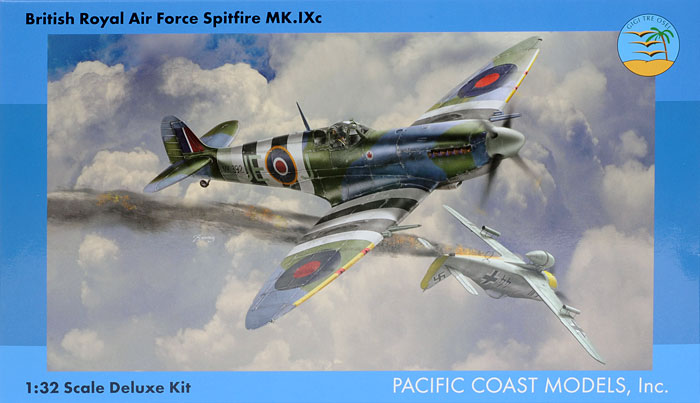
Pacific Coast Models, 1/32 scale
S
u m m a r y |
| Catalogue Number: |
Pacific Coast Models PCM 32005 - Supermarine Spitfire Mk.IXc |
| Scale: |
1/32 |
| Contents and Media: |
70 parts in blue-grey coloured plastic; 9 parts in clear; 21 resin parts; colour photo-etched fret; markings for six aircraft. |
| Price: |
USD$59.95 available online from Pacific Coast Models' website |
| Review Type: |
FirstLook |
| Advantages: |
Accurate outline; excellent detail; crisp and subtle surface features; pays attention to important design aspects (e.g. "gull " wing insert and nose contours); useful options including alternate supercharger intakes, wheels, exhausts; cannon bulges and barrels; effective use of mutli-media; large and attractive decal sheet with good selection of markings. |
| Disadvantages: |
Some flash to clean up; limited run nature of the kit will require some experience; a few detail shape questions (propeller blades, large bulges) |
| Recommendation: |
Highly Recommended. |
Reviewed by Brett Green

HyperScale is proudly supported by Squadron.com
The Focke-Wulf Fw 190 asserted its authority as soon as it appeared over the Channel Front in September 1941. It was so clearly superior to the Spitfire Mk.V that RAF Fighter Command curtailed operations twice - from November 1941 to March 1942, and again from 13 June 1942, due to unacceptably high losses against the Luftwaffe's "Butcher Bird".
The Rolls-Royce Merlin 60 series engines would offer the Spitfire the essential edge it needed to balance the scales against this new foe, but the high altitude Spitfire Mk.VII and the unpressurised Mk.VIII were still many months away from production.
An interim proposal was therefore made to provide a suitable solution in a more timely fashion. The Merlin 61 engine would be fitted to the existing Spitfire Mk.V airframe, matching the Fw 190s performance at medium and high altitudes. This aircraft was known as the Spitfire F.Mk.IX, Type No.361.
The resulting Spitfire retained the clean lines of the earlier Mks. I, II and V, but featured a longer and modified fuselage to accommodate the bigger engine, revised intakes, radiators and oil coolers, and a four-bladed propeller to handle the greater power.
The Spitfire Mk.IX underwent a number of design refinements, engine improvements and general modifications during production.
Although initially conceived as a stop-gap measure, the Spitfire Mk.IX and the essentially similar Mk.XVI (powered by a Packard Merlin engine) eventually became the most numerous of all Spitfire variants with more than 7,000 delivered to the RAF, the VVS and other Allied air forces.
The Spitfire Mk.IX continued in front line service until the end of the Second World War.
Modellers have been waiting a very long time for a 1/32 scale Spitfire Mk.IX. Until now, our only options have been expensive resin or vacform conversions requiring considerable skill and effort. I have a few of these in my collection waiting for my attitude to catch up with my enthusiasm.
At last, we have a high quality, multi-media 1/32 scale kit of this vital Spitfire variant.
Pacific Coast Models' Spitfire Mk.IXc comprises 70 parts in grey plastic, 9 parts in clear, 21 resin parts, colour photo-etched fret; markings for six aircraft.
The plastic parts have been moulded by Sword of the Czech Republic. The plastic is shiny, and surface detail is excellent - crisply recessed fine panel lines and selected rows of rivets are the order of the day. I like the rib tape detail on the rudder too. The overall impact is restrained and impressive.
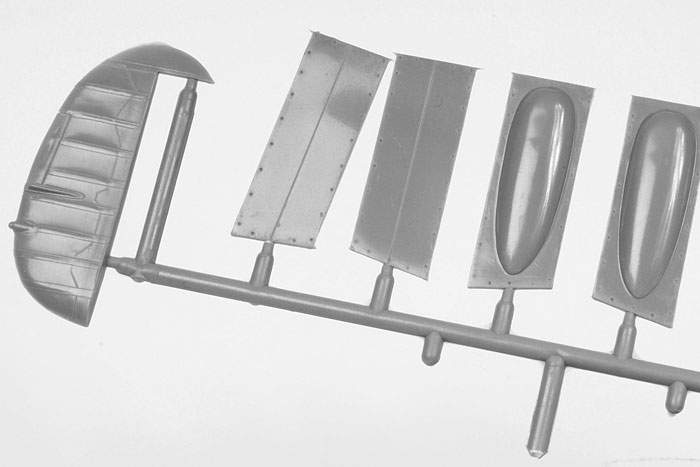
The 21 grey resin parts will be mainly used to fill out the cockpit, but also include wheels, undercarriage bays and two different styles of exhaust - flared and tubular. The two styles of wheels included are five spoke and covered hub. The five spoke wheels saw service on the Spitfire Mk.V, but many Mk.IXs were also fitted with this style of hub into 1944. A four spoke wheel was introduced for the Mk.IX during 1944. Spitfire Mk.IXc wheels were also sometimes fitted with a covered hub, which is the second option supplied in the kit (although it is probably an outrageous nit-pick on my part, the kit's covered hubs have six recessed bolts when I think that there should only be five).
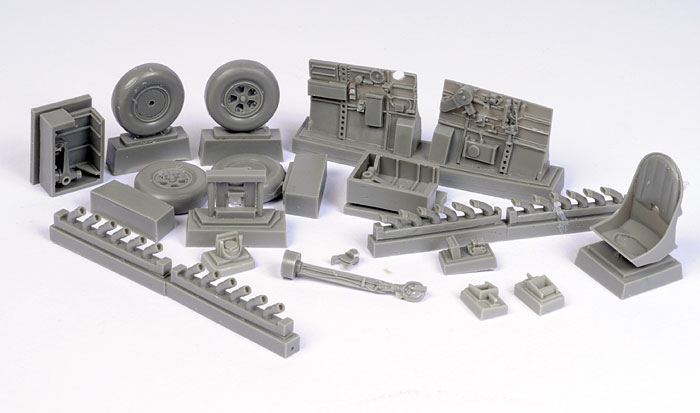
The resin parts are bristling with detail and are appropriately three-dimensional when required. The only imperfection in my kit is a short-cast hole near the top of one sidewall. It will be fairly easy to remove the offending section and glue a piece of plastic in its place.
The colour photo-etch fret offers glorious eye-candy for the front office including a beautifully detailed instrument panel, harness straps with printed stitching detail and much more.
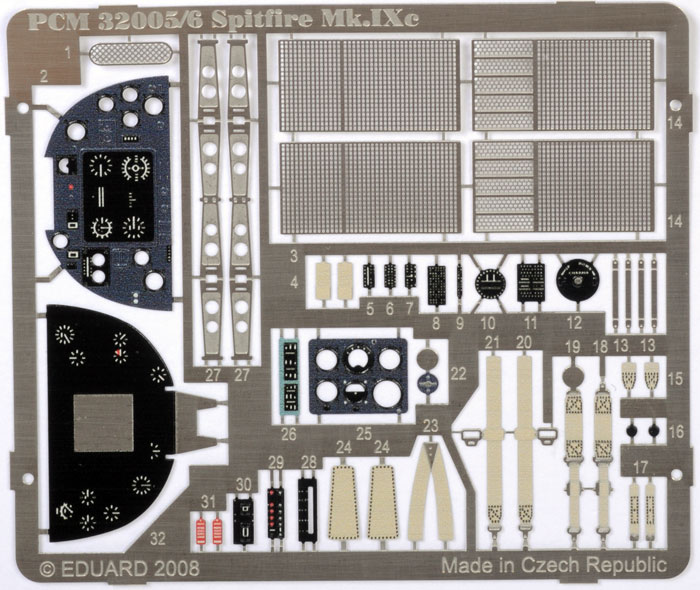
The clear parts are very nice - thinly moulded and good looking in shape. Time will tell if the centre sliding section will fit over the spine when the canopy is glued in the open position! I liked the fact that the rear view mirror was moulded in clear. The clear-moulded gunsight is much better detailed than the simple blobs often supplied in mainstream kits too.
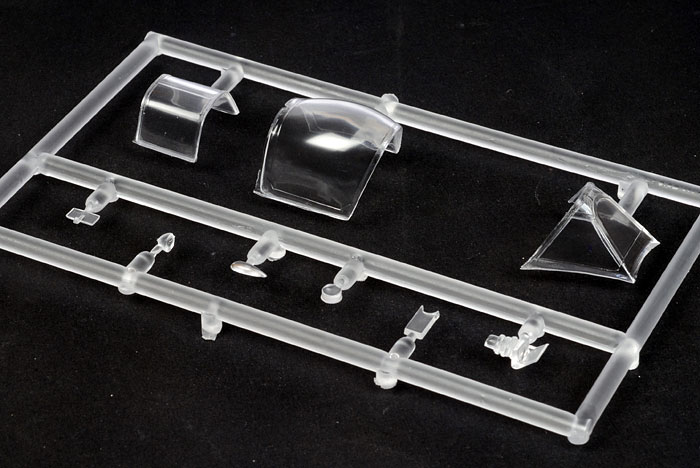
Engineering and parts breakdown looks straightforward. Being a limited run kit there are no locating pins, so take your time with test fitting and alignment before committing to glue. The lower wing is full span, with the upper wing halves supplied separately. Except for the rudder, control surfaces are moulded in the neutral position. Flaps are (mercifully) moulded in the closed/up position. The trailing edges of wings and tailplanes look pretty fine, but they will probably benefit from the attention of a sanding stick to thin them to a razor's edge.
The overall profile and plan form looks good, although I will defer to those with a more finely tuned eye for the Spitfire (would Mr Roy Sutherland and Mr Bob Swaddling please report to the front office). The only shapes that jump out at me are the leading edges of the propeller blades, which appear to be too straight, and one of the large cannon bulge options which looks totally unfamiliar. On the plus side, kudos to Pacific Coast Models for the separate "gull wing" insert at the trailing edge of the bottom wing. The limitations of the injection moulding process would be incapable of delivering this subtle yet essential Spitfire characteristic. I do like the complex contours of the nose too. Very nice.
Straight from the box, the kit may be built as a late version F.Mk.IXc. The separate narrow cannon bulges wil be used for the late IXc, and the profile of the forward fuselage suggests the flatter cowl of the Rolls-Royce Merlin engine. However, the sprues also contain the short supercharger intake, two styles of large bulged gun covers and alternate cannon barrels. All of these parts are marked with a big "X" as "not for use" on this version. Even so, these parts might all be employed to depict an early Mk. IXc. The only major items missing for this early conversion are the "unkinked" elevators, but it would be a fairly simple matter to fill the diagonal hinge lines on the kit elevators and scribe a new right angle to depict the earlier elevators. The clipped wing tips of the LF.Mk.IXc are also included on the sprues.

The large colourful decal sheet is printed by Cartograf. Colours look good (the elusive Dull Red and Dull Blue appear to be okay, although the Sky codes may be a bit insipid) and registration is perfect. Six options are offered.
I am very impressed with Pacific Coast Models' first non-Italian subject.
Pacific Coast Models' 1/32 scale Spitfire Mk.IXc is well detailed, has gorgeous surface features, and appears to be accurate in outline. With its comprehensive resin content supplemented by colour photo-etch, you won't have to spend a cent on after-market improvements, making the ticket price of USD$59.95 sound pretty reasonable.
Due to its limited-run nature, you should ideally have had some experience with short run kits or resin accessories before tackling PCM's Spitfire Mk.IXc.
However, if you take your time preparing parts and test fitting, and treat this kit with the respect that any limited run offering deserves, then you should be rewarded with a very attractive and detailed model of the most numerous Spitfire variant.
Highly Recommended.
Sample kit purchased by reviewer
Review and Images Copyright © 2008 by Brett Green
Page Created 8 May, 2008
Last updated 8 May, 2008
Back to HyperScale Main Page
Back to Reviews Page |
